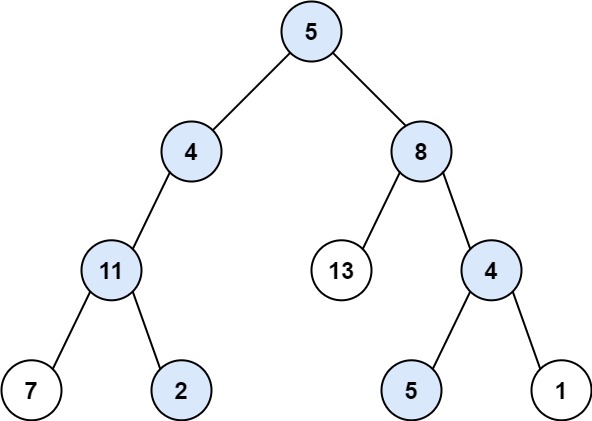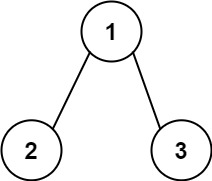Path Sum-II
Problem Description
Given the root of a binary tree and an integer targetSum, return all root-to-leaf paths where the sum of the node values in the path equals targetSum. Each path should be returned as a list of the node values, not node references.
A root-to-leaf path is a path starting from the root and ending at any leaf node. A leaf is a node with no children.
Examples
Example 1:

Input: root = [5,4,8,11,null,13,4,7,2,null,null,5,1], targetSum = 22
Output: [[5,4,11,2],[5,8,4,5]]
Explanation: There are two paths whose sum equals targetSum:
5 + 4 + 11 + 2 = 22
5 + 8 + 4 + 5 = 22
Example 2:

Input: root = [1,2,3], targetSum = 5
Output: []
Example 3:
Input: root = [1,2], targetSum = 0
Output: []
Constraints
- The number of nodes in the tree is in the range
[0, 5000]. 1000 <= Node.val <= 10001000 <= targetSum <= 1000
Code in Different Languages
C++
/**
* Definition for a binary tree node.
* struct TreeNode {
* int val;
* TreeNode *left;
* TreeNode *right;
* TreeNode() : val(0), left(nullptr), right(nullptr) {}
* TreeNode(int x) : val(x), left(nullptr), right(nullptr) {}
* TreeNode(int x, TreeNode *left, TreeNode *right) : val(x), left(left), right(right) {}
* };
*/
class Solution {
public:
vector<vector<int>> ans;
void helper(TreeNode* root,int targetsum,int currentsum,vector<int>&v){
if(root==nullptr){
return;
}
v.push_back(root->val);
currentsum+=root->val;
if(targetsum==currentsum&&root->left==nullptr&&root->right==nullptr){
ans.push_back(v);
}
helper(root->left,targetsum,currentsum,v);
helper(root->right,targetsum,currentsum,v);
v.pop_back();
}
vector<vector<int>> pathSum(TreeNode* root, int targetSum) {
if(root==nullptr){
return ans;
}
ans.clear();
vector<int> v;
helper(root,targetSum,0,v);
return ans;
}
};
Java
class Solution {
public void backtrack(TreeNode root,int target, List<List<Integer>> ans, List<Integer> list){
if(root==null){
return;
}
list.add(root.val);
if(root.left ==null && root.right==null && root.val==target){
ans.add(new ArrayList<>(list));
}else{
backtrack(root.left,target-root.val,ans,list);
backtrack(root.right,target-root.val,ans,list);
}
list.remove(list.size()-1);
}
public List<List<Integer>> pathSum(TreeNode root, int targetSum) {
List<List<Integer>> ans = new ArrayList<>();
backtrack(root,targetSum,ans, new ArrayList<>());
return ans;
}
}
Python
# Definition for a binary tree node.
# class TreeNode:
# def __init__(self, val=0, left=None, right=None):
# self.val = val
# self.left = left
# self.right = right
class Solution:
def pathSum(self, root: Optional[TreeNode], targetSum: int) -> List[List[int]]:
if not root:
return []
# dfs function to find path from root to leaf
def dfs(root,path):
# to check if node is leaf
if not root.left and not root.right:
# if leaf then check if path sum matches target sum
if targetSum==sum(path+[root.val]):
# if yes then add path to result array
return res.append(path+[root.val])
# recursively cal for left and right nodes till leaf node
if root.left:
dfs(root.left,path+[root.val])
if root.right:
dfs(root.right,path+[root.val])
# create a result array
res=[]
# call the function for root
dfs(root,[])
return res
Complexity Analysis
-
Time complexity:
O(n)Each node is visited once, so the time complexity is linear with respect to the number of nodes. -
Space complexity:
O(n)The space complexity is due to the recursion stack and the path list, both of which can go up to the depth of the tree (in the worst case, the depth is n for a skewed tree)